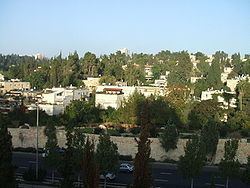 | ||
Beit HaKerem (Hebrew: בית הכרם) is a largely secular upscale neighborhood in southwest Jerusalem, Israel. It is located between Kiryat Moshe to the northwest and Bayit VeGan to the south. Beit HaKerem has a population of 15,000.
Contents
- Map of Beit HaKerem Jerusalem Israel
- History
- Education
- Parks and monuments
- Transportation
- Public services
- Notable residents
- References
Map of Beit HaKerem, Jerusalem, Israel
History
Remnants from the First Temple, Second Temple, Byzantine and Mamluk periods were discovered in a dig on HaSatat Street in 2006. It is named for the biblical city of Beit Hakerem near Jerusalem mentioned in Jeremiah 6:1 and Nehemiah 3:14.
The neighborhood was founded in 1922 as one of six garden cities developed in Jerusalem during the days of the British Mandate for Palestine. Beit HaKerem was planned by Ricard Kaufmann, an architect notable for his Bauhaus style, and was at the time separated from the rest of the city by large swaths of undeveloped land. Beit Hakerem has continued to maintain its 'green' character.
According to a census conducted in 1931 by the British Mandate authorities, Beit HaKerem had a population of 550 inhabitants, in 148 inhabited houses.
In the 1960s and 1970s, many university professors and students sought housing in Beit Hakerem due to its proximity to the Givat Ram campus of the Hebrew University, built when the Mount Scopus campus was cut off from Jerusalem in 1948.
Education
The neighborhood has 25 kindergartens, four elementary schools and three high schools considered among the most prestigious in Jerusalem. The David Yellin College of Education, established in 1913, is located in Beit HaKerem, as is the David Shapell College of Jewish Studies. A footbridge from Beit HaKerem over the Begin Highway connects to the Givat Ram campus of the Hebrew University of Jerusalem.
Parks and monuments
Gan Ha'esrim park in Beit Hakerem (Park of the Twenty) commemorates 20 residents who died in Israel's War of Independence. Denmark Square (Kikar Denya) honors the Danish people for rescuing 90 percent of its Jewish population during the Holocaust. The monument in the square is shaped like a boat, recalling the boats on which Jews were smuggled to Sweden. Two connecting parks for kids, Gan HaShachar and Gan HaGai, are also located in the neighborhood.
Transportation
The Jerusalem Light Rail, which began service in late 2011, passes through Beit HaKerem and has two stops there—Ha-'Haluts and Denia Square—providing convenient, rapid transportation to the Jerusalem Central Bus Station, the Binyanei Hauma international convention center, the soon to be completed (2018) terminus of the high-speed rail to Tel Aviv (28 minutes), Cinema City, the Machaneh Yehudah (the shuk) market, as well as to downtown Jerusalem, Zion Square, the Ben Yehudah pedestrian mall, Jerusalem City Hall, the Mamilla shopping mall and the Old City near Jaffa Gate and Damascus Gate.
Public services
Denmark Square in the center of Beit Hakerem has a number of shops, including a dry cleaners, hair salons, a stationery store, a post office, Clalit health clinic, a health food store, a book store, and a supermarket. Also in Beit Hakerem is the national headquarters of Yad Sarah, the largest voluntary organization in Israel, lending medical equipment and providing other services for free or at nominal costs. In the neighboring Ramat Beit Hakerem there is another shopping area with a supermarket, a pharmacy, a wine store, restaurants and cafés, and a bookstore. There is a private residence for senior citizens above the shops. The Shaare Zedek Medical Center, one of Jerusalem's main hospitals, is located across the street.
